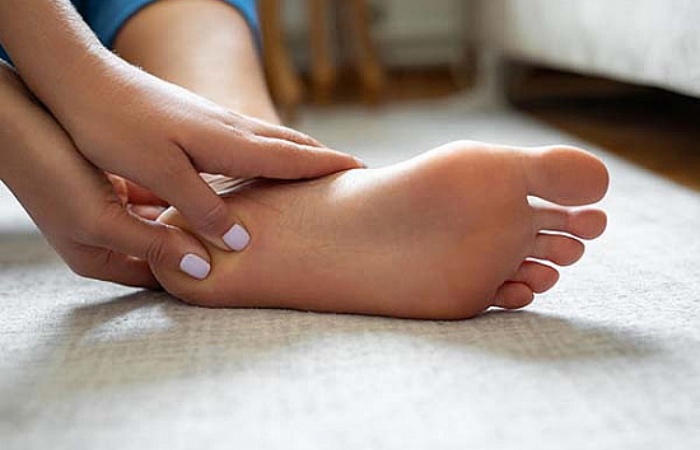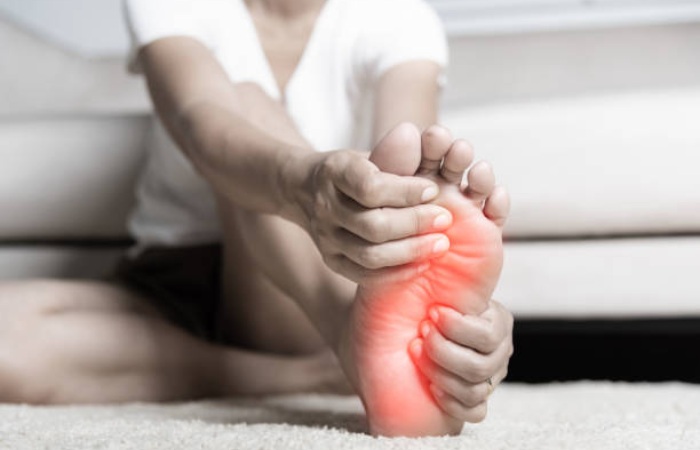Heel pain is a common problem, but is heel pain a sign of cancer? Experts say that although it is rare, heel bone cancer can cause persistent pain. If you experience unexplained severe discomfort in your heel, see your doctor. Heel swelling, although rare, may be a contributing factor. It is important to seek professional advice to rule out serious illnesses.
Glance at the topic:
- While most heel pain is due to non-cancerous conditions such as plantar fasciitis, a rare type of cancer known as Ewing’s sarcoma can occur in the heel bones.
- Heel pain is not usually a sign of cancer, but persistent pain accompanied by swelling and changes in the appearance of the skin may warrant testing for heel cancer.
- Heel swelling is rare, but when it occurs, it may be a sign of a benign growth, such as a giant cell tumour or, less commonly, a malignant tumour.
Have you ever woken up with heel pain and wondered if it was just a temporary pain or something more serious? Heel pain can be annoying and sometimes worrying. Many people, especially those who have heard about various health problems, may wonder: is heel pain a sign of cancer? This thought can be scary, but it is important to address these issues correctly.
While most cases of heel pain are caused by less serious conditions such as plantar fasciitis or heel spurs, some may wonder about the symptoms of heel cancer or whether there is any connection between foot cancer pain and other serious conditions. Knowing what could be causing your heel pain is important—not only to give you peace of mind but to make sure you’re taking the right steps to maintain your health.
Before you get too excited, let’s find out what experts have to say about heel pain and its potential link to more serious health conditions. Keep reading to find out the facts and get expert advice on this issue.
What Causes Heel Pain in One Foot

Heel pain in one foot can be confusing and frustrating. This often interferes with daily activities and makes walking uncomfortable. But what exactly causes this localized disease? Causes can range from common foot problems to less common causes.
Here, we look at the various factors that can cause heel pain.
- Plantar fasciitis: This is an extremely common cause of heel pain. This occurs when the thick band of skin that turns along the bottom of the foot becomes inflamed.
- Heel spurs: These are bony growths under the heel bone. They can develop when the plantar fascia pulls too much on the heel.
- Inflammation of the bursa, a small fluid-filled sac at the back of the heel, can cause significant discomfort.
- Stress fractures: These are small fractures of the heel bone, usually caused by repeated stress, overuse, or a strong blow.
- Pinched nerve. Sometimes, the nerve around the heel can become compressed or pinched, resulting in a sharp, shooting pain.
- Symptoms of heel cancer. While it’s rare, it’s important to know that persistent pain for no apparent reason could be a sign of something more serious, such as cancer. However, it is very rarely associated with other reasons.
Understanding what causes heel pain in one foot is the first step to finding Treatment. Although pain with leg cancer is rare, it is important not to ignore persistent pain that does not go away. If you have heel pain and don’t seem to be getting better, it’s a smart idea to see a doctor.
What are 5 Common Causes of Heel Pain?
Complaints of heel pain are common, as it can interfere with walking, running, or even just standing during daily activities.
The causes of this discomfort vary greatly, ranging from mechanical problems to more serious medical conditions.
Therefore, knowing the five common causes of heel pain helps determine how best to treat them. Let’s find out what these reasons are.
1. Plantar fasciitis
Probably the most common cause of heel pain is plantar fasciitis, an inflammation that occurs in the thick group of tissue called the plantar fascia that joins the heel bone to the toes. This condition usually causes excruciating pain and occurs when you take the first steps after getting out of bed in the morning.
Once you start moving, this type of pain tends to decrease but may return if you stand for a long time or stand up after sitting for too long. Physical therapy is often helpful as a treatment, along with good shoes and sometimes orthotics.
2. Achilles tendonitis
This mentions inflammation of the Achilles tendon, the tissue that attaches the shin strengths at the back of the leg to the heel bone. Runners often suddenly increase the intensity or duration of their run.
Signs include stiffness and pain in the Achilles tendon in the morning, severe pain after exercise, and thickening of the tendon itself. Treatment plans may consist of rest, ice, anti-inflammatory drugs, and exercises aimed at strengthening the tendon.
3. Spurs heels
They form when calcium deposits, caused by overstretching the plantar fascia, accumulate on the underside of the heel bone. They can cause sharp, knife-like pain when walking or standing but often go unnoticed because they don’t hurt.
However, they can be painful for some people, although they are otherwise usually asymptomatic. Treatment includes exercise, using custom orthotics, or injecting cortisone directly into the affected area.
4. Bursitis
The heel has a bursa, a fluid-filled sac that acts as a cushion among tendons, muscles, bones and joints. When it becomes inflamed, it results in what is called heel bursitis.
Repeatedly landing hard on surfaces such as concrete or using them excessively without adequate recovery time between workouts can lead to this condition. Wearing shoes that rub against the back of the foot can also cause the same problem.
Typically described as a deep pain on the sides or even inside the heel itself, Treatment includes resting the leg, use of heel pads for shock absorption, and anti-inflammatory drugs.
5. Cancer in the Heel
Although heel cancer is rare, it should be suspected if the pain remains constant, unexplained, and gradually worsens along with foot cancer symptoms.
Sometimes, these signs resemble less serious conditions, so it is important to consult with medical professionals for a thorough diagnosis when standard interventions fail to relieve symptoms.
Is heel pain related to kidney stones? There is no direct connection as stones typically do not cause localized soreness in the heels but rather more general areas where swelling may occur due to fluid retention, etc.
What Type of Cancer Causes Heel Pain?

When it comes to heel pain, the cause is usually not as serious as cancer. However, it is important to answer a long-standing request: Some types of cancer may present with symptoms such as heel pain.
Understanding what may link heel pain to serious medical conditions can help with early detection and Treatment.
- Bone cancer Osteosarcoma or chondrosarcoma: These cancers affect the bones and can occur in the heel. If cancer begins or spreads to the heel bone, it can cause unembellished pain, swelling, and a noticeable lump.
- Metastatic cancer: Although it is a symptom of breast cancer that may seem unrelated, breast cancer and other cancers, such as kidney, lung and prostate cancer, can metastasize and feast on the bones, including the heel. This may lead to pain as a side effect.
- Multiple myeloma: This plasma cell cancer often affects many parts of the body, including the bone marrow in various bones, which can indirectly cause heel pain due to bone damage or fractures.
- Leukemia: Although leukemia does not directly cause heel pain, it can lead to an increased danger of bone fractures due to weak bones, which can lead to heel pain.
It’s important to consider these possibilities if your heel pain is persistent, unexplained, and accompanied by other cautioning signs such as unexplained weight loss, fatigue, or changes in appetite.
Remember that heel cancer is very rare, and foot cancer symptoms often include more than just isolated pain. Always consult a doctor for a precise diagnosis and then appropriate Treatment.
Treatment Options and Management
If you are experiencing heel pain, you should learn about your treatment options and available treatments. They usually provide relief and are recommended as a first step in most cases.
However, invasive procedures may be considered if conservative approaches do not work. It is important to understand when I should be concerned about heel pain and what kind of pain is associated with heel pain so that I can make learnt decisions about my health.
Conservative Approaches
- Rest and ice. Limiting activity and using cold compresses can help reduce inflammation as well as relieve pain.
- Stretching and strengthening exercises can improve mobility and reduce pain.
- Orthopedic devices. Special or over-the-counter supports can correct structural problems and distribute pressure evenly.
- Anti-inflammatory drugs. Non-steroidal anti-inflammatory drugs. NSAIDs can help reduce pain and inflammation.
- The right shoes. Shoes that provide good arch support and cushioning can prevent further irritation.
- Change in activity. It is important to avoid activities that increase pain.
Invasive approaches
- Corticosteroid injections. These injections can be given to reduce swelling in the area and provide temporary pain relief.
- Plantar fascia release surgery – includes cutting part of the plantar fascia ligament to relieve tension and pain.
- Extracorporeal Shock Wave Therapy ESWT – uses sound waves to stimulate heel healing.
- Radiofrequency ablation – destroys nerve tissue to reduce pain signals.
- Bone spur removal. Surgery is performed to remove spurs that cause heel irritation.
- Heel reconstruction. If the deformity or injury is severe, reconstructive surgery may be required.
Final thoughts
Although heel pain is a common problem that a variety of minor conditions can cause, it is important not to ignore persistent or severe symptoms. Remember that underlying conditions that can range from mechanical problems, such as plantar fasciitis, to more serious systemic conditions.
Is it sign of cancer? That should be considered in the presence of other warning signs? They can help control the cause of your pain and recommend appropriate treatment options.
If you are experiencing tenacious pain that does not improve with primary care, consulting a doctor who specializes in breast cancer is a smart move. They can help control the cause of your pain and recommend appropriate treatment options.

